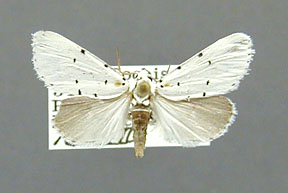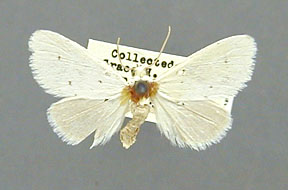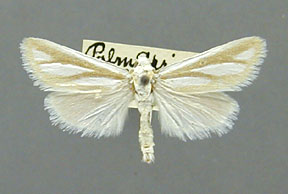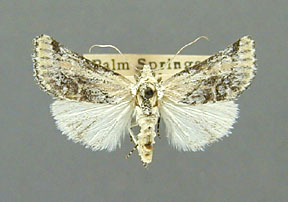
Grotella sampita

Grotelliformis lactea

Hemigrotella argentostriata

Podagra crassipes
|
The Grotellini are a small tribe of small moths
found in the southwestern United States and parts of Mexico. The adults
are commonly small, white moths, sometimes with a pattern of black dots
representing the forewing antemedial and postmedial lines. Most species
are found in the desert regions of the American southwest, but at least
one gets in the prairie regions of the Midwest. Nothing is known about
the biologies of any of the species.
The following sequence of characters should allow recognition of a member
of the tribe.
1. Tibial spines are almost always present except in Grotelliformis
lactea. The spines are presumed to be secondarily lost in this genus.
The tibial spines on the prothoracic tibia consist of two, strong apical
spines, one in either corner of the distal end of the tibia and a row
of weaker spines on either side of the tibia. The outer (cephalad side)
apical spine is typically considerably larger than the inner apical spine
(and in a couple of species the inner group of spines may be nearly absent
in almost all specimens. The exception in Podagra crassipes where
the spines are randomly scattered on the dorsal face of the tibia and
are all extremely strong and blunt tipped. The mesothoracic tibial spines
typically consist of a row of spines running along the inner side of the
tibia from the proximal end of the tibia to the basis of the tarsal spur.
The spines may be arranged in a linear row, or the spines may be less
regular. Most species also have one or two spines at the distal end of
the tibia. The metathoracic tibia usually has only one spine located between
the two pairs of tibia spurs on the outer side of the tibia, although
some species or specimens may lack any spines at all. This overall tibial
spining plan is also found in the Heliothinae and the tribes Agrotini
and Noctuini of the Noctuinae.
2. A prominent frontal process is present. The frontal process consists
of an outer ring whose lower margin is absent, ending at the level of
the central protuberance. However the clypeal margin is strongly produced
and it appears as if an entire ring is present, but interrupted on either
side at the level of the central protuberance. The dorsal margin of the
outer ring has a v-shaped indentation, and in Grotella citronella
the entire dorsal portion of the ring is absent. The entire outer ring
is absent in Grotelliformis. A central protuberance is always
present and usually consists of an elongate cylinder with the apex circular.
The protuberance may be laterally compressed (longer dorsally-ventrally
than laterally) and in the spaldingi species group of Grotella
the central protuerance is compressed into a blade or nose-shaped process.
The central protuberance is reduced to an irregular knob in Grotelliformis
3. An accessory cell is present in the forewing. Veins R3 and R4 are stalked
about one-third to one-half the distance from the end of the accessory
cell to the apex of the forewing and R5 arises separatly from just below
the apex of the accessory cell. Hindwing vein M2 is present and strong,
although not as strong as either M1 or M3. Veins M3 and Cu1A both arise
from the lower angle of the discal cell and are not stalked. The cross-vein
mdc is about one and one-half times longer than ldc. The venation is otherwise
as in the "trifid" noctuids on the whole.
4. The genera and species of the Grotellini are almost all closely scaled
and tufts do not play a major part in the vesititure of the group.
5. Basal abdominal hair pencils and Stobbe's Glands are absent in all
the genera and species of the tribe.
6. The eyes are naked and lack lashes in all genera and species.
7. The internal tympanic structure is simplified and apparently reduced.
Pocket I is triangular, consisting of a simple frame without internal
regions. Pocket II is present, but consists of a simple frame without
internal regions. Pocket III is present, small, and not fused with the
tympanal air sac. Pocket IV is moderate in size and completely inclosed.
8. The external tympanic region is reduced. An alula is present, but very
weak. The anterior half of the tympanic membrane is very small and triangular.
The entire tympanal membrane is bent outward at the position of the nodal
sclerite, the membrane appearing triangular in three dimensions. A nodal
sclerite is present and linear, but sometimes very weak. The first abdominal
tergum is narrow and hemispherical with only the caudal fourth or third
sclerotized. The rest of the tergum is membranous with the cephalad margin
strongly rounded. A tympanal groove is present and is angled inward to
the midline following the direction of the lower margin of the first tergum,
reflexing the entire intersegmental membrane region of the first abdominal
segment inward. This tendency is strongest in Grotelliforma and
Podagra, somewhat less strongly defined in Grotella.
The intersegmental membrane bearing the spiracle is triangular without
any definite bulla, and the spiracle may be difficult to see because of
the inward slant of the first abdominal segment. The hood completely absent.
The tympanal groove is not continued on the second abdominal segment.
9. The male genitalia are typically very reduced and of great diversity.
The valve is typical a rectangular or elongate- triangular structure,
most often without any other structure. The valve lacks a corona and the
clasper is usually absent, but present in a few species, e.g. Grotella
stretchi. A digitus- like projection of the lower margin of the valve
is present in Grotella blanchardi and G. margueritaria.
The uncus is usually long and simple. A free pleurite is present, broadly
articulated with dorsal-outer margin of the tegumen, and clearly articulated
with the vinculum. The transtilla is nearly always well developed and
unmodified and the juxta consists of a single quadrate plate. The vesica
of the aedoeagus is variable and may be either globular or elongate, but
typically bears spine-like cornuti.
10. The female genitalia are variable. The ovipositor lobes are usually
unmodified, but the ovipositor neck length is variable between species,
and is very elongate in a few species. The ostium is typically membranous
and located in the membrane between the seventh and eighth abdominal segments.
The ductus bursae is normally membranous. The appendix bursae is located
at the caudal end of the corpus bursae, although its exact structure is
variable between species. The corpus bursae may be globular or elongate
with a capitate cephalad end.
The larvae and their foodplants are unknown.
|


